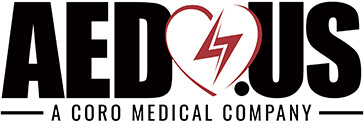An Automated External Defibrillator (AED) is a high-powered, life-saving device that requires ongoing maintenance and care. In this guide, we’ll discuss our recommendations for proper AED storage and maintenance requirements to ensure it’s always ready for rescue and in compliance. Keep reading to learn more and see our six-step AED checklist.
Proper AED Storage
AEDs are critical pieces of equipment and must be appropriately stored to ensure they are accessible and ready for use in the event of an emergency. We recommend the following when choosing where to place an AED:
- Staff Know the Location: In some instances, people have encountered a cardiac emergency where someone called for an AED, but staff could not recall where it was placed. To prevent this, companies should provide AED training to their employees and ensure they know where to find it.
- Locked vs. Unlocked: Since AEDs can be expensive, many people secure them in a locked cabinet. If this is the route you choose, make sure someone with a key is always on-hand to unlock it. Otherwise, avoid locking it away to ensure faster response times during an emergency.
- Accessibility is Key: Wherever you store the AED, ensure there is always a clear path to access it.
What Equipment Should You Keep with an AED?
It’s essential to always keep your AED with an installed battery, plus a set of adult AED pads, spare pads, and pediatric AED pads. We also recommend pairing a rescue kit with your AED that includes scissors to cut a patient’s shirt, a razor to shave a patient’s chest, latex gloves for protection, and a mouthpiece for CPR.
AED Maintenance Requirements
Even if an AED is accessible, it’s useless if it isn’t well maintained. The last thing anyone wants is to grab an AED during an emergency only to find that the batteries have died. Proper maintenance requires a combination of AED inspection and regular testing to guarantee it’s always ready for rescue. But how often should an AED be inspected? The requirements vary by manufacturer and can be found in your user manual, but we recommend doing an in-depth inspection monthly using the checklist below.
Six-Step AED Checklist
- Examine the device for signs of damage.
- Check the AED’s power by turning it on and off.
- Ensure the status indicator light shows the AED passed its internal self-test and is ready to be used.
- Check the date on pads and batteries to make sure they are not expired.
- Confirm that additional rescue supplies are stocked with the AED, including gloves, a razor, and a breathing mask.
- Initial and date your AED inspection card.
AED Management Simplified with myAED.US
If your AED maintenance requirements are overwhelming given the size of your organization’s needs or if you’d rather not take on the burden of managing your AEDs from a spreadsheet, myAED.US AED Program Management is here to support you.
Here are some of the features of our state-of-the-art AED program management:
- Receive compliance information for every state in which your organization operates.
- Receive automated email reminders about visual inspections and expiration dates.
- Order supplies directly from a link within the notification emails that you will receive 60 and 30 days before expiration.
- Manage your AEDs on a mobile device with our app.
- Store data on inspections electronically.
- EMS registration.
- Medical direction and Physician’s review of events.
- Receive a loaner AED if needed.
- Gain access to our Resource Center with training materials, video tutorials, and user manuals.
Visit our AED Program Management page if you want to learn more or enroll your organization.
 Written by Blaire Czarniecki
Written by Blaire CzarnieckiCustomer Service Director
Blaire attended the University of Tennessee where she graduated with a Bachelor of Science in Human Ecology- Child and Family Studies. She has been in the Automated External Defibrillator (AED) industry for over eight years and is the Director of Customer Service for Coro Medical. Blaire is also an American Red Cross certified CPR/AED/First Aid Instructor, highly trained by each manufacturer on their specific AEDs, and knowledgeable regarding ALL State AED regulations and legislation.“I know that every day I come to work, I am playing a part in saving someone’s life. I am passionate about these devices and am always looking for new and innovative ways to spread awareness and knowledge about Sudden Cardiac Arrest (SCA). I look forward to the day when everywhere I go, I will see an AED—when SCA will no longer take any lives.”
Last updated January 31, 2022





